Scientists are sounding the alarm that a crucial component of the planet's climate system is in gradual decline and could one day reach a tipping point that would radically alter global weather patterns.
The Atlantic Meridional Overturning Circulation, or AMOC, is a system of ocean currents that circulate water in the Atlantic Ocean like a conveyor belt, helping to redistribute heat and regulate global and regional climates. However, new research warns that the AMOC is weakening with a warming climate and could suffer a dangerous and abrupt collapse with global consequences.
“This is bad news for the climate system and humanity,” researchers from the Institute of Marine and Atmospheric Research at Utrecht University wrote in a new study published in the journal Science Advances.
(Paul Duginski / Los Angeles Times)
Given that the AMOC is the workhorse of the Atlantic, the consequences of such a collapse would result in “wildly chaotic changes in global weather patterns” that would extend far beyond the Atlantic, said Daniel Swain, a climate scientist at UCLA. who did not participate in the study. study.
“It would plunge Europe into an essentially regionalized Ice Age, while leaving the rest of the world on its path of continued warming,” Swain said. “The Southern Hemisphere would burn up, the Pacific storm track would go a little crazy, and you would get these extreme changes in weather patterns that are very different than what you would expect from a more incremental or linear warming trajectory.”

Aggressive and impactful reporting on climate change, the environment, health and science.
The odds of such a collapse are low (about 5% or 10% this century, according to some researchers), but the consequences are so great that it would be unwise to ignore the possibility, Swain said.
“There is still a [90%] There's a 95% chance that won't happen, but would you be willing to bet the farm on a [90%] Is there a 95% chance that something like this won't happen? he said. “Would you get on a plane if there was a [90%] At 95% chance it won't crash? “I certainly wouldn’t.”
The AMOC moves water in the Atlantic Ocean from north to south and back again in a long cycle, but there are signs that it has been weakening over the last century, including a decline of about 15% since 1950.
The system is based on a delicate balance between warm surface water and cold, salty water sinking to the sea floor, which together keep the current churning. But as the planet warms, melting glaciers and ice sheets, like the Greenland Ice Sheet, are adding more fresh water to the system, which is diluting its salinity and disrupting traditional patterns.
“It's a self-powered feedback loop that primarily affects salinity, and the cooler the North Atlantic Ocean becomes, the weaker the AMOC becomes, until a critical value is reached,” said René van Westen, lead author of the study.
The study does not set a time frame for when such a collapse might occur, and Van Westen said such estimates may be controversial. But the paper was the first to show that the AMOC can reach a tipping point if enough fresh water is added to the system.
“There is still intense debate about whether this is a possibility in the 21st century, but we cannot rule it out at the moment,” he said.
A similar scenario played out in the movie “The Day After Tomorrow,” although experts say the events of that movie, which take place over the course of a few days, are highly dramatized.
Dutch researchers say models indicate that an AMOC collapse is possible and that such an event would significantly alter the planet's climate. Its effects would be most acute in Europe, where temperatures could drop by up to 18 degrees on average, or even by as much as 36 degrees in places like Norway and Scandinavia. It could also trigger “wobble” conditions between the northern and southern hemispheres.
Other potential effects include rapid sea level rise, with a possible rise of more than 2 feet in some coastal regions, including the Netherlands and the East Coast of the United States. New York City could be inundated by a rise of up to 31 inches in sea level, Van Westen said.
The Amazon rainforest would change its dry and wet seasons, which could lead to its own tipping point. (A separate study published this month found that parts of that rainforest could collapse as early as 2050.)
Effects on the Pacific Ocean and the U.S. West Coast would likely be minor due to their distance from the Atlantic, Van Westen said. However, his modeling shows that an AMOC collapse could result in reduced precipitation and slight cooling in Los Angeles, which would compete with the broader climate change signal toward regional warming.
In fact, the possible future collapse of the AMOC is in some ways a different scenario from the effects of climate change that are already occurring, said UCLA's Swain. Currently, climate change is primarily amplifying pre-existing patterns and risks, such as worsening wildfires in California or more extreme downpours and flooding.
“But a collapse of the global circulation would really be different, because it would lead to rearrangements of the jet stream, of the storm track, whose places on Earth are really cold compared to other places,” he said.
The jet stream, the river of air that moves storms eastward around the world, often helps direct atmospheric rivers toward California.
Such disturbances would not only affect climate and temperature conditions, but would also tear the fabric of civilization. Agriculture in Europe would likely stop, while coastal cities would suffer major problems due to flooding. Building codes and infrastructure could become obsolete as seasonality and precipitation patterns quickly shift places from warm to cold, and vice versa.
“It would mean that all the climate adaptation we're working on now wouldn't necessarily be the climate we would be experiencing,” Swain said.
Other experts said some of the scenarios described in the study are on the edge of plausible. The model required exceptional amounts of freshwater flow into the Atlantic to trigger the tipping point (an amount equivalent to about seven Greenland ice sheets), according to Josh Willis, an oceanographer at NASA's Jet Propulsion Laboratory in La Cañada. Flintridge.
“It's still possible that the repeal ends, and if it does, it will have big implications,” Willis said. “But it's not one meter of sea level right away or 15 degrees Celsius of cooling right away. It's not 'The day after tomorrow.'”
Still, Willis said the system may be more sensitive than previously thought, and that future models and simulations could add to the growing body of work. Other recent studies have also warned of an upcoming collapse of the AMOC and a possible collapse of the Southern Ocean Current.
“It's an interesting study,” he said of the latest paper, “and the AMOC could still prove capable of shutting down. But this study is not necessarily conclusive in this regard. There are still many open questions.”
Lynne Talley, a distinguished professor at the Scripps Institute of Oceanography at the University of California, San Diego, similarly said there is “natural variability” in the AMOC that can include strengthening and weakening on a time scale of about a decade, and He warned against combining recent changes with a long-term trend.
However, he said the research into its possible collapse is compelling and worthy of consideration.
“First of all, it's possible… I wouldn't hesitate to say that,” he said.
Salinity studies are particularly valuable, he added, because salinity helps control the density of water in the AMOC. A similar mechanism may have caused the fall of the AMOC at the end of the last glacial period, about 14,000 years ago.
Back then, a lot of fresh water was swept into the North Atlantic by the melting North American ice sheet, “and that clearly slowed it down and kind of stopped it,” Talley said.
“It seems completely plausible to me that it will crash at some point, and control is salt,” he said. “But in what year does that happen? I don't know.”
Such a collapse would likely be irreversible, at least on any time scale relevant to human life. But there are safeguards to prevent such a collapse from occurring: namely, reducing emissions of methane, carbon dioxide and other fossil fuels that are warming the planet, melting ice and releasing more fresh water into the ocean.
“That's really the solution to everything,” Talley said. “I think we have to protect ourselves against many things related to climate change, and this is one of the most important for the northern hemisphere.”












